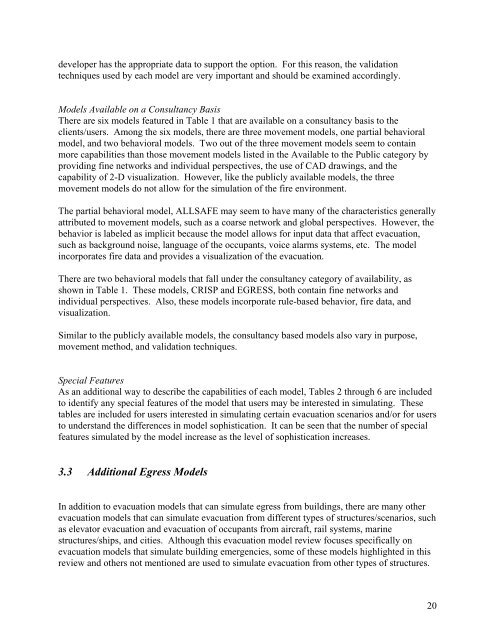A Review of Building Evacuation Models - NIST Virtual Library
A Review of Building Evacuation Models - NIST Virtual Library
A Review of Building Evacuation Models - NIST Virtual Library
You also want an ePaper? Increase the reach of your titles
YUMPU automatically turns print PDFs into web optimized ePapers that Google loves.
developer has the appropriate data to support the option. For this reason, the validation<br />
techniques used by each model are very important and should be examined accordingly.<br />
<strong>Models</strong> Available on a Consultancy Basis<br />
There are six models featured in Table 1 that are available on a consultancy basis to the<br />
clients/users. Among the six models, there are three movement models, one partial behavioral<br />
model, and two behavioral models. Two out <strong>of</strong> the three movement models seem to contain<br />
more capabilities than those movement models listed in the Available to the Public category by<br />
providing fine networks and individual perspectives, the use <strong>of</strong> CAD drawings, and the<br />
capability <strong>of</strong> 2-D visualization. However, like the publicly available models, the three<br />
movement models do not allow for the simulation <strong>of</strong> the fire environment.<br />
The partial behavioral model, ALLSAFE may seem to have many <strong>of</strong> the characteristics generally<br />
attributed to movement models, such as a coarse network and global perspectives. However, the<br />
behavior is labeled as implicit because the model allows for input data that affect evacuation,<br />
such as background noise, language <strong>of</strong> the occupants, voice alarms systems, etc. The model<br />
incorporates fire data and provides a visualization <strong>of</strong> the evacuation.<br />
There are two behavioral models that fall under the consultancy category <strong>of</strong> availability, as<br />
shown in Table 1. These models, CRISP and EGRESS, both contain fine networks and<br />
individual perspectives. Also, these models incorporate rule-based behavior, fire data, and<br />
visualization.<br />
Similar to the publicly available models, the consultancy based models also vary in purpose,<br />
movement method, and validation techniques.<br />
Special Features<br />
As an additional way to describe the capabilities <strong>of</strong> each model, Tables 2 through 6 are included<br />
to identify any special features <strong>of</strong> the model that users may be interested in simulating. These<br />
tables are included for users interested in simulating certain evacuation scenarios and/or for users<br />
to understand the differences in model sophistication. It can be seen that the number <strong>of</strong> special<br />
features simulated by the model increase as the level <strong>of</strong> sophistication increases.<br />
3.3 Additional Egress <strong>Models</strong><br />
In addition to evacuation models that can simulate egress from buildings, there are many other<br />
evacuation models that can simulate evacuation from different types <strong>of</strong> structures/scenarios, such<br />
as elevator evacuation and evacuation <strong>of</strong> occupants from aircraft, rail systems, marine<br />
structures/ships, and cities. Although this evacuation model review focuses specifically on<br />
evacuation models that simulate building emergencies, some <strong>of</strong> these models highlighted in this<br />
review and others not mentioned are used to simulate evacuation from other types <strong>of</strong> structures.<br />
20
















